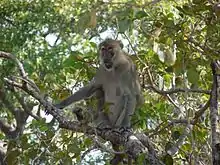Kinda baboon
The Kinda baboon (Papio kindae) is a species of baboon present in the miombo woodlands of Angola, the Democratic Republic of the Congo, Zambia, and possibly western Tanzania. While the Kinda baboon was once thought to be a subspecies of the yellow baboon (Papio cynocephalus), it has recently been discovered to be distinct enough to merit status as separate species (P. kindae) under the phylogenetic species concept.[3]

| Kinda baboon[1] | |
|---|---|
 | |
| Scientific classification | |
| Kingdom: | Animalia |
| Phylum: | Chordata |
| Class: | Mammalia |
| Order: | Primates |
| Suborder: | Haplorhini |
| Infraorder: | Simiiformes |
| Family: | Cercopithecidae |
| Genus: | Papio |
| Species: | |
| Subspecies: | P. c. kindae |
| Trinomial name | |
| Papio cynocephalus kindae Lönnberg, 1919 | |
The Kinda baboon is golden in color with a light build and slender, lanky appearance. Their fur is somewhat longer and is less coarse and much softer compared to other baboon species. It is the smallest of all baboons; adult males are about the size of adult females of other baboon species.[3][4] The Kinda baboon is also characterized by a shorter snout and pink circles around the eyes. Infants are usually born with white hair rather than black, typical of other baboons.[5] Sexual dimorphism in kinda baboons is more moderate than in any other baboon subspecies.[6]

Baboons in between the size of the Kinda baboon and the yellow baboon are present in northeastern Zambia, and possibly in northern Malawi and southwestern Tanzania as well.[7][8] Such a broad area of intergradation has been taken as evidence of substantial genetic exchange between the two taxa.
The Kinda baboon lives in multi-male and multi-female groups, similar to olive and yellow baboons,[5]however, they are often much larger in size (often over 100 individuals). Compared to other baboon species, the Kinda baboon is unusually docile and uniquely characterized by high levels of male investment in male-female social relationships. Strict social hierarchy with female permanent rank obtained from the mother was observed as in other species. Males join new groups and may rise in rank, but unlike other baboon species, violent confrontations are mostly avoided.[9] More research is needed about its behavior.
The Kinda is named after the town in southern DRC where the type-locality was found.[10]
References
- Groves, C. P. (2005). "Papio cynocephalus kindae". In Wilson, D. E.; Reeder, D. M (eds.). Mammal Species of the World: A Taxonomic and Geographic Reference (3rd ed.). Johns Hopkins University Press. p. 166. ISBN 978-0-8018-8221-0. OCLC 62265494.
- Kingdon, J. (2016). "Papio kindae". IUCN Red List of Threatened Species. 2016: e.T136848A92251482. doi:10.2305/IUCN.UK.2016-1.RLTS.T136848A92251482.en.
- Petersdorf, Megan; Weyher, Anna H.; Kamilar, Jason M.; Dubuc, Constance; Higham, James P. (2019-10-01). "Sexual selection in the Kinda baboon". Journal of Human Evolution. 135: 102635. doi:10.1016/j.jhevol.2019.06.006. ISSN 0047-2484. PMID 31421317.
- Jolly, C.J. (1993). "Species, subspecies, and baboon systematics". In W.H. Kimbel; L.B. Martin (eds.). Species, Species Concepts, and Primate Evolution. New York.
- Rogers J, Burrell AS, Cotterill FP, Jolly CJ (2004). "A preliminary report on the 'kinda' baboons of Zambia". Folia Primatologica. 75 (S1): 61.
- "Kinda Baboons". Kasanka Baboon Project. Retrieved 2021-01-14.
- Freedman L (1963). "A biometric study of Papio cynocephalus skulls from northern Rhodesia and Nyasaland". Journal of Mammalogy. Journal of Mammalogy, Vol. 44, No. 1. 44 (1): 24–43. doi:10.2307/1377165. JSTOR 1377165.
- Ansell WF, Dowsett RJ (1988). Mammals of Malawi. St. Ives: The Trendrine Press.
- Weyher, Anna H.; Phillips-Conroy, Jane E.; Fourrier, Marc S.; Jolly, Clifford J. (2014). "Male-Driven Grooming Bouts in Mixed-Sex Dyads of Kinda Baboons (Papio kindae)". Folia Primatologica. 85 (3): 178–191. doi:10.1159/000362544. ISSN 0015-5713. PMID 25012475. S2CID 42289552.
- "Contributions to the knowledge about the monkeys of Belgian Congo". Revue zoologique africaine. 7: 107–154. 1919. doi:10.5962/bhl.part.15112. ISSN 0771-0488.
